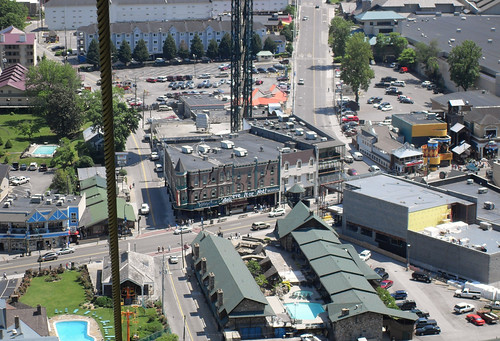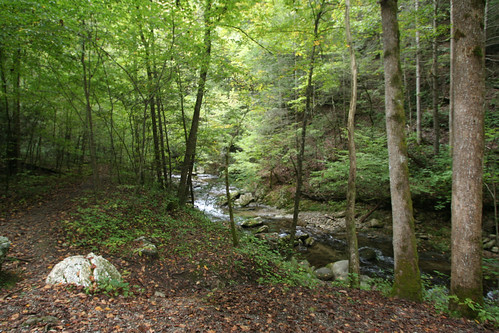Loving a place to death . . . or not: communities near our great land- and waterscapes (by Lee Epstein)

Posted July 25, 2012 at 1:34PM
Today I am pleased to present another insightful essay by my frequent collaborator, Lee Epstein. Lee is an attorney and land use planner working for sustainability in the Mid-Atlantic region.
The United States is wonderfully blessed by having within (or adjoining) its borders some magnificent natural wonders, some of which are renowned international treasures. Places such as the Grand Canyon and Yosemite come to mind, as do Cape Cod, the Great Lakes, the Florida Everglades, Big Sur, the Oregon Coast, Lake Tahoe, Denali, the mountains, deserts, and open ranges of the Intermountain West, the volcanoes and beaches of Hawaii, and the Chesapeake Bay. There are many, many more such places, both large and small. Areas of incomparable beauty, these places harbor extraordinarily rich and valuable, but also fragile or abused, ecosystems.
Some of these places enjoy the protection of the federal government through ownership and direct stewardship, at least to the extent shrinking federal budgets allow. Others are almost entirely in private hands, are surrounded by private lands, or contain resources that are extensively utilized in some way. Many of these areas are obviously where people want to live, work, or visit – sometimes in great numbers, but sometimes to the detriment of the resource itself.
This topic was recently presented in an excellent article by Josh Stevens in the California Planning and Development Report, concerning the continuing growth management dilemma around one of these places, the bi-state Lake Tahoe. To say that the Lake is an extraordinary resource is an understatement: More than a mile above sea level, Tahoe is the largest alpine lake in North America. At more than 1,600 feet deep, this 191-square-mile freshwater lake is known for its amazing cerulean blue color and incredible clarity. It is surrounded by high mountains, mixed conifer forests, wet and dry meadows, vast snowfields… and people: casinos, towns and villages, roads, resorts and ski/snowboard destinations. With people have come nutrient and (mostly) sediment pollution loading into the lake, largely from stormwater runoff, leading to consistent reductions in clarity.
There is a California-Nevada regional management agency responsible for Tahoe, and it has made progress over the years; but it is sorely pressed today as it wrestles with the next generation of plans for the area.
Such a tale is not as unique as is its setting. The Tahoe area is blessed by the intense focus and interest of its citizens (even with their insistent, contrasting views), a competent regional planning agency, and excellent data and scientific support -- but so are many of the other wonderful natural areas in our nation. What is also similar is the challenge posed by people: loving a place so much (and some would say exploiting it equally as much) that there exists the quite real risk of overwhelming it. How to manage development and change in such a place becomes an over-arching question.
Of course, not all places of great natural value and beauty are wrestling chiefly with this singular issue. Range and ranchland management, agriculture, energy development, water management, and fisheries management are issues of equal of more weight in some places. But where land development and the accommodation of increasing numbers of residents, workers, and visitors present the greatest environmental challenges, the management issues posed are similar: can we continue to grow as we have, or at best, how should we grow at all?
(Note: This blog posed very similar questions with regard to a historic Tuscan village in “Can we balance the old and new as a place evolves?” in which we highlighted Sarah Marder’s film, The Genius of a Place.)
Voices and opinions in such places vary, often with the economic or environmental interests they are representing. Resort, hotel (and casino, condo, and second-home) developers usually want total freedom to develop property to the “highest and best use,” either as densely or spread-out as they see fit, designed in whatever way the market will bear, and maximizing return on their investment. Chambers of Commerce often seek the most development they can get, because it means that opportunities to grow businesses in the area can increase. Environmental groups often want the least development possible, and have not historically been fans of towns, cities, or any density whatsoever. City or regional councils and planning commissions find themselves in the middle: trying to satisfy multiple constituencies, but also seeking the best way forward so as not to kill the goose that’s laying the golden eggs (the natural resource itself). As in Tahoe, in some of these places right now the debate is raging not only about how much development is appropriate, but exactly how and where it may be accommodated, and what kind of development it should be.
So here I posit a principle: Sustainable, smart growth is sustainable, smart growth, no matter where it occurs. There are, of course, scale issues. The kind of density and intensity of use expected in a large city or highly urban area is probably not appropriate in a medium-sized one, nor in a small town; Boston’s downtown office towers don’t belong in Dennis or Brewster, and San Francisco’s high-rise hotels don’t belong in Healdsburg. And, surely, there are design differences pertaining to place and context – not every place is geo-physically, culturally, socially or economically the same, and not every place should be treated as if it were by planners or urban designers.
But the major components of smart, sustainable growth are nevertheless the same: compactness and avoidance of sprawl, enough density to bring about the co-location of businesses, restaurants, offices, and the varying needs of daily living; safe and inviting, walkable streets and access to regular, efficient transit; green features that effectively treat stormwater and substantially reduce or eliminate its adverse impacts to water quality; and the protection of existing buffers, streams and arroyos, well-managed working lands, and open space beyond developed areas. Where towns and related development are next to special natural areas, good walking, biking or transit access should be provided to such places.
Mostly what this means is that redevelopment should be welcomed with reasonable scale and intensity increases, while new development on undeveloped land is usually unwise. It is one thing for a town or city, or a regional plan, to legitimately state up front that its expected “build-out” will be in the year “20xx,” or once the population reaches “yy.” It is quite another, however, to merely say that, along the way to that point, the town or region should not grow any more densely but rather should be allowed to continue to spread out like the thinnest layer of peanut butter on a piece of bread – with all the adverse environmental implications such a pattern creates for the area’s precious, spectacular natural resources that have brought folks to the region in the first place.
We must take special care of the wonderful natural wonders in this country with which we have been entrusted. Sustainable and smart growth precepts are one way to do that.
Lee Epstein’s most recent contribution to this blog was “The Plumbers' Law, or how sustainable development helps watersheds” (June 11, 2012).
Related posts:
- Can we balance the old and new as a place evolves? (December 28, 2011)
- Land conservation, smart growth and the environment (December 6, 2011)
- Video week: the conservation imperative for smart growth (July 22, 2011)
- Musings on vacation sites, consumption, and resilient communities (July 16, 2010)
- Exemplary smart, green development will complement the historic character of medieval Weilburg (October 28, 2009)
Move your cursor over the images for credit information.




